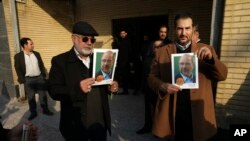RFE/RL contributed to this report.
Iran's Interior Ministry said Sunday voter turnout in recent parliamentary elections stood at 42.57%, the lowest since the 1979 Islamic Revolution.
Obsevers say the number could be an indication of overall discontent with Iran's clerical rulers and the state of the economy under intense pressure from the United States.
Interior Minister Abdolreza Rahmani Fazli announced the participation rate and added that such a scenario "seems perfectly acceptable for us."
"We held these elections when there were various incidents in the country: we had bad weather, there was this coronavirus disease, there was the plane crash," he said, citing Iran's January 3 shoot down of a Ukrainian airliner that killed 176 people.
In the 2016 election, turnout was nearly 62% and has been consistently above 50% since the country’s Islamic Revolution. Voters also had limited options on Friday's ballot. More than 7,000 candidates were disqualified. among them reformists and moderates.
About 90 disqualified candidates were sitting members of Iran's 290-seat parliament who tried to run for re-election.
Iran’s State TV reported that hard-liners won all 30 parliamentary seats in Tehran. The semi official Fars news agency predicted that conservative candidates would win 135 total seats, while reformists were to gain 20 seats and independents 28.
Iranian officials urged people to cast their ballots Friday as a form of resistance against U.S. sanctions that have sent the economy into recession.
Though voting numbers were low, Supreme Leader Ayatollah Ali Khamenei said on Sunday voters came to polls in a "huge participation" despite "negative propaganda" by foreign media.
It "began a few months ago and grew larger approaching the election and in the past two days, under the pretext of this illness," he said, according to a televised speech.
The day before Iran’s election, the Trump administration sanctioned a number of election officials, including the 92-year-old cleric who leads the Guardian Council responsible for the vetting of candidates.
U.S. Secretary of State Mike Pompeo has called the election a "sham."
Out of 80 million people, about 58 million Iranians were eligible to vote. More than 24 million voted and 48% were women.
State TV showed former Tehran mayor Mohammad Bagher Qalibaf as winner in the capital with more that 1.2 million votes.
Qalibaf is also a top contender for the parliament speaker position.
Also on Sunday Iran reported three new coronavirus deaths, taking its toll to eight -- the highest in any country outside China. It said there were 43 virus infections nationwide.










